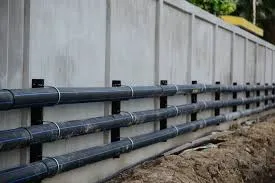ພ.ຈ. . 30, 2024 18:31 Back to list
Understanding PPR Pipes and Fittings for Efficient Plumbing Solutions
Understanding PPR Pipes and Fittings An Overview
In recent years, PPR (Polypropylene Random Copolymer) pipes and fittings have gained significant popularity in the plumbing and construction industries. Known for their durability, flexibility, and cost-effectiveness, PPR pipes are increasingly being used in various applications for both residential and commercial purposes. This article aims to provide an overview of PPR pipes and fittings, highlighting their advantages, applications, and installation process.
What are PPR Pipes and Fittings?
PPR pipes are made from a type of polypropylene plastic known as random copolymer. This material is characterized by its high resistance to corrosion and chemical damage, making PPR pipes an excellent choice for transporting water and other fluids. PPR fittings, on the other hand, are the connectors, joints, and accessories used in conjunction with PPR pipes to create a complete plumbing system. These fittings come in various shapes and sizes, including elbows, tees, couplings, and flanges, allowing for versatile configurations.
Advantages of PPR Pipes and Fittings
1. Durability One of the most significant advantages of PPR pipes is their durability. They are resistant to abrasion, chemicals, and corrosion, which typically affect other piping materials such as metal and PVC. This longevity leads to lower maintenance costs and fewer replacements over time.
2. Lightweight PPR pipes are considerably lighter than traditional materials like metal, making them easier to transport and install. Their lightweight nature also reduces the structural load on buildings and frameworks.
3. Temperature Resistance PPR pipes can withstand a wide range of temperatures, typically from -20°C to 95°C (-4°F to 203°F). This feature makes them suitable for both hot and cold water applications.
4. Easy Installation The installation process for PPR pipes is straightforward as they can be heat-welded together, eliminating the need for complex fittings or adhesives. This process not only speeds up installation but also ensures a leak-proof system.
ppr pipes and fittings

5. Cost-Effective While the initial investment in PPR pipes may be comparable to other materials, their durability and low maintenance requirements result in long-term cost savings. Additionally, the ease of installation can reduce labor costs.
Applications of PPR Pipes and Fittings
PPR pipes and fittings are versatile and can be applied in various settings. Some common applications include
- Residential Plumbing Many homeowners are using PPR pipes for water supply systems, drainage, and heating applications. - Industrial Applications PPR pipes are ideal for industrial settings where corrosive chemicals are present, as they can safely transport chemicals without degrading. - Air Conditioning and Refrigeration Due to their thermal stability, PPR pipes are being used in HVAC systems for both hot and cold water circulation. - Irrigation Systems Farmers are turning to PPR pipes for their irrigation needs due to their resistance to UV rays and soil corrosion.
Installation Process
Installing PPR pipes requires specific tools and techniques. Initially, the necessary lengths of pipe are measured and cut using a pipe cutter. The ends of the pipes are then heated with a special welding tool until they reach the appropriate temperature. Once heated, the ends of the pipes are pressed together, forming a permanent bond. After installation, it’s essential to allow the joints to cool properly to ensure strength and reliability.
Conclusion
PPR pipes and fittings represent a modern solution for plumbing and piping needs across various sectors. Their numerous advantages, including durability, lightweight, and ease of installation, make them an attractive option for both new constructions and renovations. As industries continue to evolve, the role of PPR pipes will likely expand, further contributing to environmentally friendly and efficient plumbing systems. Whether for residential use or industrial applications, PPR pipes and fittings are positioned to remain a staple in the plumbing world for years to come.
-
High Transparency PVC Clear Sheet Super Transparency PVC Sheets & HDPE Cutting Board Supplier
NewsJul.04,2025
-
High-Quality PVC-M Pipe Supplier Trusted PVC Pipe Company & 75mm PVC Connection Pipe Solutions
NewsJul.04,2025
-
PVC Transparent Sheet Roll - Durable & Flexible PVC Plastic Sheet Roll for Industrial & Home Use
NewsJun.24,2025
-
High-Quality PVC PPR Pipes and Fittings Durable ERA PPR Solutions
NewsJun.10,2025
-
High-Quality Large HDPE Sheets & Large Diameter PVC Pipe Durable Large PVC Pipe Supplier
NewsJun.10,2025
-
High Density Polyethylene Cutting Board - Durable & Food Safe
NewsJun.09,2025

